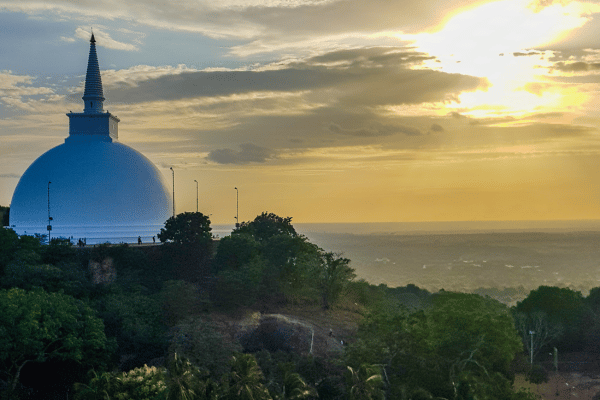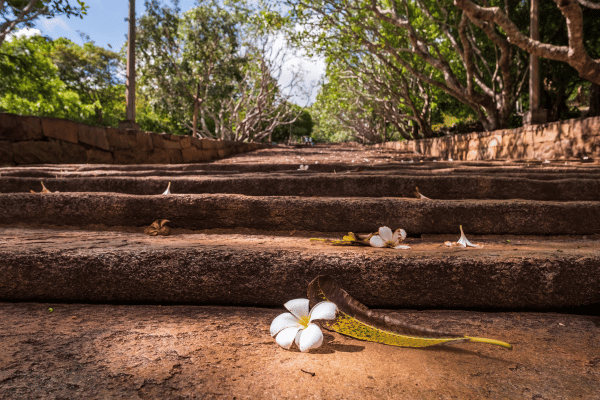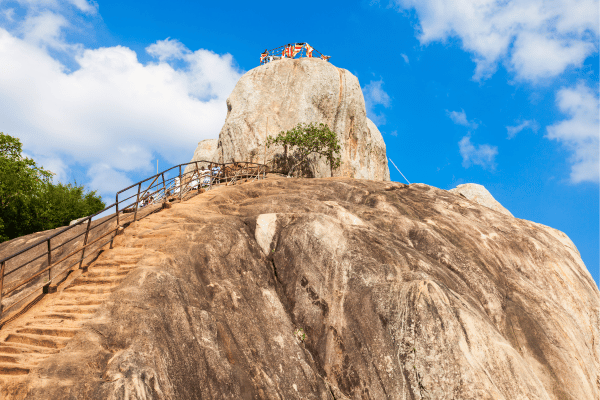Historical and religious site located in Sri Lanka ‘ Mihintale ‘ – By Malsha – eLanka

Mihintale is a significant historical and religious site located in Sri Lanka. It is situated approximately 12 kilometers east of the city of Anuradhapura, which was once the ancient capital of Sri Lanka. Mihintale holds immense importance for Buddhists as it is believed to be the place where Buddhism was introduced to the island nation.
According to legend, in 247 BCE, King Devanampiyatissa of Sri Lanka encountered the Buddhist monk Mahinda on Mihintale Mountain. Mahinda was the son of Emperor Ashoka of India, who played a pivotal role in spreading Buddhism across the region. It is said that during their meeting, Mahinda initiated King Devanampiyatissa and his followers into the Buddhist faith, marking the formal introduction of Buddhism to Sri Lanka.
Today, Mihintale is a popular pilgrimage site for Buddhists and attracts tourists from all over the world. The site features various ancient structures, religious monuments, and natural beauty. One of the prominent attractions is the Mihintale Stupa, also known as the Mahaseya, which is a large dagoba (dome-shaped structure) believed to enshrine relics of Lord Buddha. It stands tall on the summit of Mihintale Mountain and offers panoramic views of the surrounding countryside.
Visitors can also explore other notable sites in Mihintale, such as the Aradhana Gala, or the “meditation rock,” where it is said that Mahinda meditated and gave sermons to his followers. There are also several cave complexes in the area that served as dwellings for monks in ancient times. The Ambasthala Dagoba, Kantaka Cetiya, and Kaludiya Pokuna are among the other attractions worth visiting.
Mihintale is not only a place of religious significance but also a site of natural beauty. The area is surrounded by lush greenery, forests, and wildlife, making it a tranquil and serene destination for visitors. The annual Poson Poya festival, commemorating the arrival of Buddhism to Sri Lanka, is celebrated with great enthusiasm at Mihintale, drawing large crowds.
To explore Mihintale, it is recommended to wear comfortable footwear and carry water, as there are several steps to climb when visiting the various sites. The best time to visit is during the early morning or late afternoon to avoid the heat, as Sri Lanka can have a tropical climate.
Overall, Mihintale holds a significant place in Sri Lanka’s history and is a must-visit destination for those interested in Buddhism, ancient architecture, and natural beauty.

Why is mihintale important?
Mihintale is considered important for several reasons:
- Introduction of Buddhism: Mihintale is believed to be the place where Buddhism was first introduced to Sri Lanka. According to tradition, the meeting between King Devanampiyatissa and the Buddhist monk Mahinda took place on Mihintale Mountain. This event marked a crucial turning point in the religious and cultural history of Sri Lanka, as Buddhism became the dominant faith in the country.
- Pilgrimage Site: Mihintale is a significant pilgrimage site for Buddhists. Devotees visit the site to pay homage to the historical and religious significance of the place. They often climb the steps to reach the summit of Mihintale Mountain, where they can offer prayers and participate in religious ceremonies.
- Historical Significance: Mihintale is home to various ancient structures and monuments that showcase the rich history of Sri Lanka. The Mihintale Stupa, also known as the Mahaseya, is a prominent landmark believed to enshrine relics of Lord Buddha. Other structures, such as the Aradhana Gala and cave complexes, provide insights into the lives of monks and the ancient Buddhist civilization that thrived in the area.
- Natural Beauty: Mihintale is surrounded by scenic landscapes and natural beauty. The lush greenery, forests, and panoramic views from the top of Mihintale Mountain create a serene and peaceful atmosphere. The combination of historical significance and natural splendor makes Mihintale an attractive destination for visitors seeking both cultural and natural experiences.
- Cultural Festivals: Mihintale plays a significant role in cultural festivals and celebrations in Sri Lanka. The annual Poson Poya festival, which commemorates the arrival of Buddhism to Sri Lanka, is celebrated with great fervor at Mihintale. During this festival, thousands of devotees gather at the site to engage in religious activities, light oil lamps, and participate in processions.
Overall, Mihintale’s importance lies in its association with the introduction of Buddhism to Sri Lanka, its role as a pilgrimage site, its historical significance, its natural beauty, and its cultural festivals. It is a place where religious, historical, and natural elements converge, attracting visitors from various backgrounds to explore and appreciate its significance.

Mihintale is located in the Anuradhapura District of the North Central Province in Sri Lanka. It is situated about 12 kilometers east of the ancient city of Anuradhapura, which was once the capital of Sri Lanka. Mihintale is positioned on a hill, known as Mihintale Mountain or Mihintale Rock, which rises approximately 1,000 feet (300 meters) above the surrounding plains.
The geographical coordinates of Mihintale are approximately 8.3667° N latitude and 80.4833° E longitude. The area experiences a tropical monsoon climate, characterized by hot and humid conditions throughout the year.
Mihintale Mountain is part of a larger mountain range known as the Aradhana Gala range. The terrain consists of rocky outcrops, boulders, and forested areas. The lush vegetation surrounding Mihintale adds to its natural beauty and provides a habitat for various plant and animal species.
The site offers stunning views of the surrounding countryside, including paddy fields, lakes, and distant hills. The mountainous landscape, combined with the greenery, creates a tranquil and picturesque setting for visitors.
To reach Mihintale, visitors can travel from Anuradhapura by road. There is a well-paved road that leads to the site, and transportation options such as taxis, tuk-tuks (three-wheeled vehicles), and buses are available.
Overall, the geography of Mihintale is characterized by its elevated location on Mihintale Mountain, its rocky terrain, lush vegetation, and the scenic beauty of the surrounding landscape.
several places of interest that visitors

In Mihintale, there are several places of interest that visitors can explore. Here are some notable sites to visit:
- Mihintale Stupa (Mahaseya): Located at the summit of Mihintale Mountain, the Mihintale Stupa is a significant religious monument. It is a large dagoba (dome-shaped structure) believed to enshrine relics of Lord Buddha. Visitors can climb the steps to the top and admire the stupa while enjoying panoramic views of the surrounding landscape.
- Aradhana Gala (Rock of Invitation): This rock is considered a sacred site where Mahinda, the Buddhist monk, is believed to have delivered sermons to King Devanampiyatissa and his followers. It offers a breathtaking view of the surroundings and provides a peaceful setting for meditation and reflection.
- Cave Complexes: Mihintale is home to several cave complexes that served as dwellings for monks in ancient times. These caves, such as Mihindu Guhawa, Ambasthala Vihara, and Indikatu Seya, feature ancient inscriptions, rock-cut statues, and intricate Buddhist carvings.
- Kaludiya Pokuna: This is a historic reservoir located in Mihintale, known for its tranquil surroundings. Kaludiya Pokuna, meaning “Black Water Pond,” is believed to have been used by Buddhist monks for bathing and meditation. It is surrounded by lush greenery and provides a serene atmosphere for relaxation.
- Kantaka Cetiya: This is a stupa located near the Mihintale Mountain. Kantaka Cetiya is believed to be the spot where King Devanampiyatissa’s horse was tied during his encounter with Mahinda. The stupa stands as a testament to the historical significance of the site.
- Ambasthala Dagoba: Situated on a rocky outcrop, the Ambasthala Dagoba is an ancient stupa. It is said to have been built at the location where Mahinda first set foot in Sri Lanka. The dagoba offers a beautiful view of the surrounding area.
Apart from these specific sites, exploring the natural beauty of Mihintale is also recommended. The mountainous terrain, greenery, and panoramic views create a serene environment for visitors to enjoy.
It’s important to note that while visiting these places, it is advisable to dress modestly and respectfully, as Mihintale holds religious significance for Buddhists. Additionally, carrying water and wearing comfortable footwear is recommended, as there are several steps and uneven paths to navigate in some areas.







